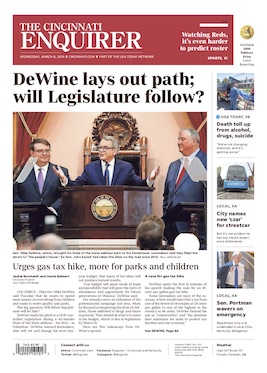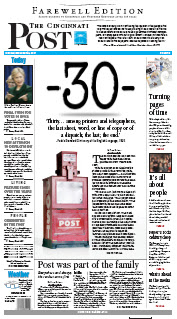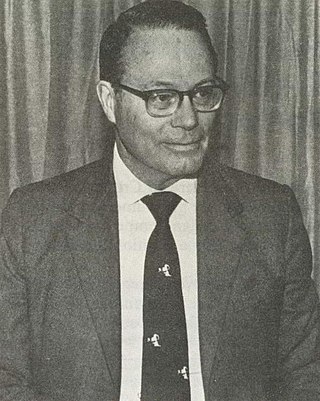Related Research Articles

Hearst Communications, Inc., often referred to simply as Hearst, is an American multinational mass media and business information conglomerate based in Hearst Tower in Midtown Manhattan in New York City.
The E. W. Scripps School of Journalism is part of the Scripps College of Communication at Ohio University. Founded in 1924, the school has been recognized by The Associated Press and U.S. News & World Report for excellence in instruction and research in the fields of journalism and mass communications. The program was recently recognized as a Center of Excellence by the Ohio Board of Regents, and has attracted more than $54 million in grants, awards and investments. The School of Journalism is accredited by the Association for Education in Journalism and Mass Communication. The school's current director as of March 2020, Edith Dashiell, joined OHIO in 1992.

The Cincinnati Enquirer is a morning daily newspaper published by Gannett in Cincinnati, Ohio, United States. First published in 1841, the Enquirer is the last remaining daily newspaper in Greater Cincinnati and Northern Kentucky, although the daily Journal-News competes with the Enquirer in the northern suburbs. The Enquirer has the highest circulation of any print publication in the Cincinnati metropolitan area. A daily local edition for Northern Kentucky is published as The Kentucky Enquirer.

The Cincinnati Post was an afternoon daily newspaper published in Cincinnati, Ohio, United States. In Northern Kentucky, it was bundled inside a local edition called The Kentucky Post. The Post was a founding publication and onetime flagship of Scripps-Howard Newspapers, a division of the E. W. Scripps Company. For much of its history, the Post was the most widely read paper in the Cincinnati market. Its readership was concentrated on the West Side of Cincinnati, as well as in Northern Kentucky, where it was considered the newspaper of record. The Post began publishing in 1881 and launched its Northern Kentucky edition in 1890. It acquired The Cincinnati Times-Star in 1958. The Post ceased publication at the end of 2007, after 30 years in a joint operating agreement with The Cincinnati Enquirer.
The Columbus Citizen-Journal was a daily morning newspaper in Columbus, Ohio published by the Scripps Howard company. It was formed in 1959 by the merger of The Columbus Citizen and The Ohio State Journal. It shared printing facilities, as well as business, advertising, and circulation staff in a joint operating agreement with The Columbus Dispatch. The last paper printed was on December 31, 1985.
The Chicago Daily News was an afternoon daily newspaper in the midwestern United States, published between 1875 and 1978 in Chicago, Illinois.

Edward Willis Scripps, was an American newspaper publisher and, together with his sister Ellen Browning Scripps, founder of The E. W. Scripps Company, a diversified media conglomerate, and United Press news service. It became United Press International (UPI) when International News Service (INS) merged with United Press in 1958. The E. W. Scripps School of Journalism at Ohio University is named for him.

The E. W. Scripps Company is an American broadcasting company founded in 1878 as a chain of daily newspapers by Edward Willis "E. W." Scripps and his sister, Ellen Browning Scripps. It was also formerly a media conglomerate. The company is headquartered at the Scripps Center in Cincinnati, Ohio. Its corporate motto is "Give light and the people will find their own way", which is symbolized by the media empire's longtime lighthouse logo.
The Newspaper Preservation Act of 1970 was an Act of the United States Congress, signed by President Richard Nixon, authorizing the formation of joint operating agreements among competing newspaper operations within the same media market area. It exempted newspapers from certain provisions of antitrust laws. Its drafters argued that this would allow the survival of multiple daily newspapers in a given urban market where circulation was declining. This exemption stemmed from the observation that the alternative is usually for at least one of the newspapers, generally the one published in the evening, to cease operations altogether.

James Edmund Scripps was an American newspaper publisher and philanthropist.

Ellen Browning Scripps was an American journalist and philanthropist who was the founding donor of several major institutions in Southern California. She and her half-brother E. W. Scripps created the E. W. Scripps Company, America's largest chain of newspapers and patron of the Scripps National Spelling Bee, linking Midwestern industrial cities with booming towns in the West. By the 1920s, Ellen Browning Scripps was worth an estimated $30 million, most of which she gave away.

William Emerson Ritter was an American biologist.
Colonel Milton Alexander McRae was an American newspaper publisher who co-founded the Scripps-McRae League of Newspapers and United Press International. The son of Helen and Duncan Van McRae, he was born in Detroit, Michigan in the United States.
Harrison McJohnston was an American organizational theorist and professor of business communication and advertising.

Edward Walker Estlow was a journalist and businessman, best known as CEO at the E. W. Scripps Company from 1976 to 1985. The Edward W. and Charlotte A. Estlow International Center for Journalism and New Media at the University of Denver, and the Edward Estlow Printing Plant of the Denver Newspaper Agency, were both named after him. Estlow was also known as a college football player.
The Houston Press was a Scripps Howard daily afternoon newspaper, founded in 1911, in Houston, Texas. Under the leadership of founding editor Paul C. Edwards (1911–16), Marcellus E. Foster, known as "Mefo" (1927–37), and George Carmack (1946–64), the newspaper developed a reputation for flashy stories about violence and sex and for exposés of political malfeasance. It ceased publication in 1964.

The Washington Bee was a Washington, D.C.-based American weekly newspaper founded in 1882 and primarily read by African Americans. Throughout almost all of its forty-year history, it was edited by African American lawyer-journalist William Calvin Chase. The newspaper was aligned with the Republican party. It was published, with gaps in 1893 and 1895, until 1922, shortly after editor Chase's death.

The Rare Book & Manuscript Library at the University of Illinois at Urbana–Champaign (RBML) is located on the 3rd floor of the University Library. The library is one of the largest special collections repositories in the United States. Its collections, consisting of over half a million volumes and three kilometers of manuscript material, encompass the broad areas of literature, history, art, theology, philosophy, technology and the natural sciences, and include large collections of emblem books, writings of and works about John Milton, and authors' personal papers.
The Chicago Newspaper strike of 1912 is a strike that ran from May until November. It was primarily held by the pressmen, and supported by other unions such as the stereotypers. The pressmen union attempted to bring attention to conglomerate newspaper publishers' attempts at breaking up printing unions.
The Chicago circulation wars were a period of competition between William Randolph Hearst's Chicago Evening American and both Robert R. McCormick's Chicago Tribune and Victor Lawson's Chicago Daily News in the early 1900s that devolved into violence and resulted in more than 20 deaths.
References
- 1 2 3 "About the day book". Chronicling America. Library of Congress. Retrieved October 30, 2014.
- ↑ Stoltzfus 2007, p. 1.
- ↑ Russell, Charles Edward (May 1914). "How Business Controls News". Pearson's Magazine . 31 (6): 552–554 – via Google Books.
- ↑ Stoltzfus 2007, p. 2.
- 1 2 Stoltzfus 2007, pp. 4–5.
- ↑ Stoltzfus 2007, p. 45.